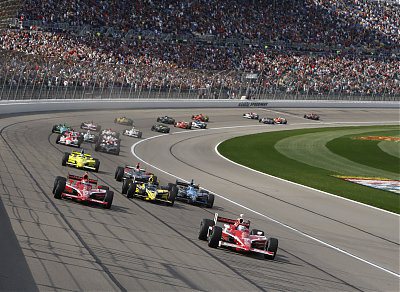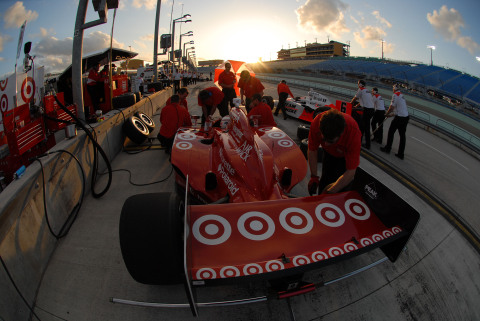The Way It Is/ Brian Lisles's fuel efficiency formula
by Gordon Kirby Brian Lisles is one of the most experienced men in the Indy car garage area. Lisles has been in the sport for more than thirty years, starting in 1979 with the Tyrrell F1 team. After eleven years with Tyrrell Lisles joined Newman/Haas in 1989 as Mario Andretti's engineer and in 2001 he was promoted to the general manager's job at Newman/Haas. Today, Lisles oversees everything from Newman/Haas's operating budget to the engineering department and team organization.
Brian Lisles is one of the most experienced men in the Indy car garage area. Lisles has been in the sport for more than thirty years, starting in 1979 with the Tyrrell F1 team. After eleven years with Tyrrell Lisles joined Newman/Haas in 1989 as Mario Andretti's engineer and in 2001 he was promoted to the general manager's job at Newman/Haas. Today, Lisles oversees everything from Newman/Haas's operating budget to the engineering department and team organization.
Like many of us in recent years Lisles has done a lot of thinking about what the Indy car rules should be and he's reached some interesting conclusions. "I've always said that I'm not the right guy to write the rules," Lisles remarks. "My job is to find the maximum amount from the rulebook for our cars and team, not to write the rules. But over the last couple of years I've been thinking quite a lot about how we should define our cars."
Lisles says much of his thinking coalesced at February's Detroit Auto Show. "I went to the Delta Wing announcement and I enjoyed walking around the auto show," Lisles relates. "I thought the Ford stand was mighty impressive. They had the Taurus show engine there--3.5 liter, econoboost turbocharged V-6 with four valves per cylinder and direct injection--way more technology than today's racing engine. It had beautifully made parts and looked like a racing engine with an open top cylinder block.
"Then of course the hybrid technology just blows you away--little 1.4 liter in-line four-cylinders with four valves per cylinder and what looks like more computers than NASA ever had attached to the electronics running it all. The electronics are working so hard they're all water-cooled. Very impressive electronic engineering and the fact of the matter is we can't walk away from all this stuff."
Lisles believes Indy car racing must become relevant and linked to the new technologies being unleashed by the fast-changing automobile industry. Like many others, Lisles thinks the key element is the amount of power the new Indy car's engine should deliver. As Lisles and many others say, it's all about efficiency.

© LAT USA
"It's all about efficiency and effectively that's what Ben Bowlby has done with the Delta Wing. Ben is saying the same thing. Everybody talks about the 'Batmobile' and what it looks like, but really that's all irelevant. What Ben's saying is that the Delta Wing formula is going to be restricted to around 300 horsepower. It's about achieving efficiency. That's what all the manufacturers are shooting for these days and for the forseeable future."
Lisles proposes a fuel formula with a limited amount of onboard fuel and no refuelling.
"This is probably simplistic," he muses. "But what if the rulesmakers said we don't care what engine you run. The only rule is you have to do the Indy 500 using no more than fifty gallons of fuel. You're going to get fifty gallons of fuel to do the Indy 500 and thirty gallons of fuel to do the 300-mile oval races and twenty-five or thirty gallons of fuel for the road races. Make it about fuel efficiency and have a clear, straightforward way of defining it.
"Absolutely we need to have more efficient engines and cars. I think we need to be able to advertise that we fill up with fifty gallons of fuel at the start of the Indy 500 and we do 500 miles on one tank of fuel at 225 mph. You promote the fact that we used to have to stop for fuel six or seven times and now we're going to do 500 miles without any pitstops. And the only way you can do that is to use gasoline because if you used ethanol you'd have to use 100 gallons and it would be stretching it to build a car with a hundred gallon tank. So I think we need to go back to using gasoline.
"If we went down that road," Lisles adds, "maybe in a few years we would be doing the Indy 500 on forty gallons of fuel instead of fifty and the sport could showcase improvements in fuel mileage and efficiency"
Of course, Lisles has thought about how to limit the engine's power in qualifying.
"To limit the amount of power for qualifying you would have a can of fuel that you plugged in for qualifying. There would be a measured amount of fuel in the can. So as you roll up to do your qualifying run you clip this preconfigured can into the fuel system. At Indy you would get one and a quarter gallons of fuel to do two warm-up laps, plus your four-lap, ten-mile qualifying run and you would advertise that the drivers qualify for the Indy 500 using only one gallon of fuel."
Lisles says removing all the refuelling equipment from a team's inventory would save a fair amount of money.

© LAT USA
What kind of engines would result from a fuel formula like Lisles suggests?
"First of all, revs kill efficiency because the faster the engine turns the more the frictional losses," Lisles observes. "So the first thing you would want is an engine that would probably run at 5,000-6,000 rpm, maybe 7,000. But you would want to run pretty low revs and that means that internally you don't produce the loads that you do with high rpm and you don't need to have big strong connecting rods, crankshafts and blocks. So you would be able to build a pretty light engine which is a big plus in itself and because it's not running high revs it's inherently a low stress engine so its life goes up. It's also lightly turbocharged so you recover some of the energy from the exhaust gases.
"Many years ago Keith Duckworth was asked what would be the most efficient engine and he said it would be a big 6-liter V-8 lightly turbocharged and running at 5,000 rpm. With that you'd get twice as much power from the same amount of fuel. The physics don't change. Technology helps us make better use of the physics but the physics don't change.
"It would be interesing to see what engines would be developed for a real efficiency-based formula. You might see a 2.5 liter in-line four-cylinder, or 3.0 liter V-6 lightly turbocharged running at 6,000 rpm. It would be great to have diversity of engines."
Like the Delta Wing, Lisles's formula would result in a much smaller, lighter car.
"If you have only 300 horsepower it doesn't take much to transmit that horsepower to the wheels," Lisles says. "So you can have a much lighter gearbox and you don't need such wide tires. The whole car can be smaller and lighter."
Lisles believes that retaining cutting edge electronics is essential to having a truly relevant technological formula.
"To get the most bang out of any fuel you need today's sophisticated electronics," Lisles observes. "Look at what the car industry is doing. Mercedes-Benz, for example, is testing the current prototype S class autobahn cruiser which is sometimes chauffeur-driven and the version they're working on right now gets 40 mpg.

© LAT USA
Lisles points out that electronic control systems have taken over even in the 150-year old machine tool industry.
"We can make all this fancy stuff using machine tools that work exactly the same way as they did in Victorian times," he remarks. "But they're controlled by computer software rather than somebody standing there pushing on a handle. So if we want to be relevant in a technical sense we cannot walk away from the world of electronics because it's around us everywhere. Of course, if you're willing to be just a sport you can follow the NASCAR model."
In contrast, Lisles ruminates about ways to reduce a team's expenses by placing serious restrictions on an Indy car's electronic data-collecting system.
"One of the primary reasons that our teams are so expensive to run is because the engines are sophisticated and relatively expensive," Lisles says. "We also have a very sophisticated data system on the car. To use it properly you need two or three people per car to get somewhere close to what it's capable of doing to help you go faster. So the question is, do you need that? Is it worth the cost of having three pretty well-qualified people, plus the system itself? Would it be a worthwhile cost-saving and how would you get rid of it? I'm not sure that I can answer that question but that's about the only way you can put in reverse some of the electronic revolution."
So there you have the thinking of a man who's spent most of his working life in big-time auto racing. Lisles is looking as hard as he can at ways to both develop and control the sport. His ideas are intriguing and I hope the IRL gives them due consideration as the gestation process continues toward determining the Indy car of the future.
Auto Racing ~ Gordon Kirby
Copyright 2010 ~ All Rights Reserved
Copyright 2010 ~ All Rights Reserved
Top of Page